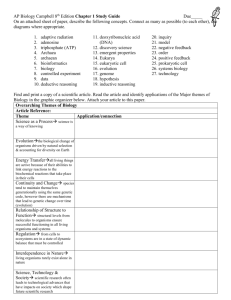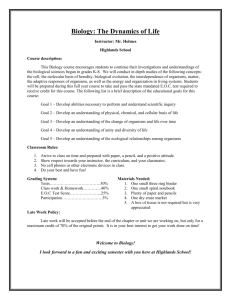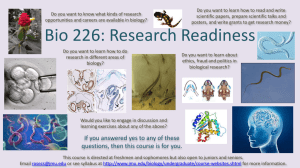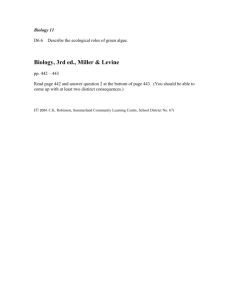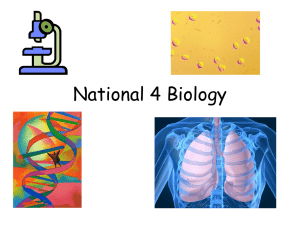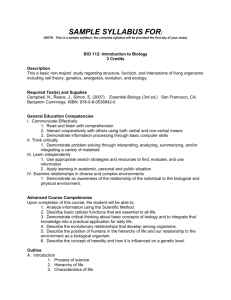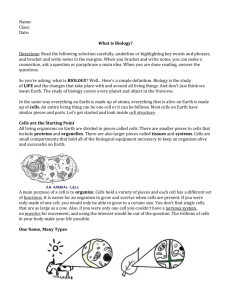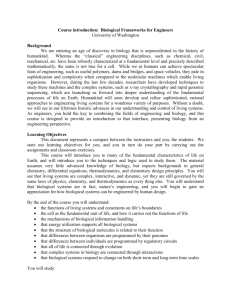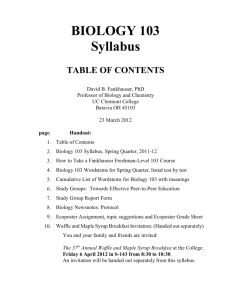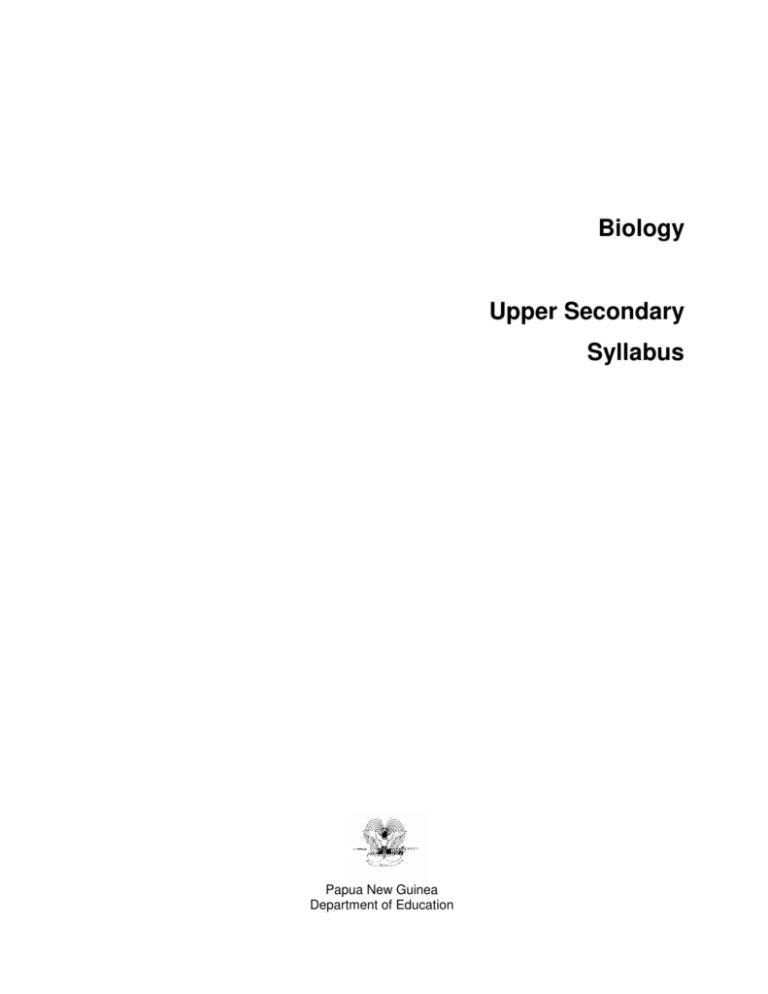
Biology
Upper Secondary
Syllabus
Papua New Guinea
Department of Education
Issued free to schools by the Department of Education
Published in 2008 by the Department of Education, Papua New Guinea
© Copyright 2008, Department of Education, Papua New Guinea
All rights reserved. No part of this publication may be reproduced, stored in a
retrieval system or transmitted by any form or by any means electronic,
mechanical, photocopying, recording or otherwise without the prior written
permission of the publisher.
ISBN 978-9980-9923-2-1
Acknowledgements
The Upper Secondary Biology Syllabus was written, edited and formatted by
the Curriculum Development Division of the Department of Education. The
development of the syllabus was coordinated by Jane Yanimu Ecneme
Pagelio.
Writers from schools, tertiary institutions and non-government organisations
across the country have contributed to the writing of this Biology syllabus
through specialist writing workshops and consultations. Quality assurance
groups and the Science Subject Advisory Committee have also contributed
to the development of this syllabus.
This document was developed with the support of the Australian
Government through the Education Capacity Building Program.
Contents
Secretary’s message ...................................................................... iv
Introduction......................................................................................1
Rationale .........................................................................................3
Aims ................................................................................................4
Strands ............................................................................................5
Learning outcomes ..........................................................................6
Unit sequence and structure ............................................................7
Grade 11 units .................................................................................8
Grade 12 units ...............................................................................25
Assessment components, weightings and tasks ............................36
Assessment, examinations and certification...................................37
Secretary’s message
This Biology syllabus is to be used by teachers of Biology to teach Upper
Secondary students (Grades 11 and 12) throughout Papua New Guinea.
This syllabus builds upon science concepts, skills and attitudes learnt in
Lower Secondary and provides a sound foundation for further learning.
The Upper Secondary Biology Syllabus conforms to the National Education
Plan’s vision, which is that secondary education enables students to achieve
their individual potential to lead productive lives as members of the local,
national and international community. It provides opportunities for students
to deepen their understanding of advanced biological knowledge. Students
are prepared to deal with biological, moral and ethical issues brought about
through local, national and international developments and changes.
Teachers of Biology play a pivotal role by being innovative, creative and
keeping abreast of new information based on scientific research and
technological changes. The challenge for teachers of Biology is to engage
student learning in realistic contexts for increased and better understanding.
Engaging in such learning helps students appreciate that humans are part of
nature and continue to have a greater influence on the environment than any
other species.
Through learning Biology, students identify patterns in nature and
understand that all living organisms carry out similar processes to form the
structures that make up their bodies. They also consider the impact of
human activities, both on the organisms and ecosystems that constitute the
biosphere and on individual human beings and human society in Papua New
Guinea and the world. Applying an understanding of Biology helps students
to appreciate culture, ethics, economics, power relationships and other
factors that influence the pursuit of science and have significant impacts on
the way people live. The study of Biology enables students to make informed
decisions about modifying and interacting with nature.
This syllabus incorporates fundamental biology units that provide the
foundation for higher learning in fields such as medicine and health,
agriculture and the environment, and prepares students continuing on to
further education at tertiary level and other professional courses. Besides
providing students with the conceptual background in biology needed to
meet the challenges of academic and professional courses, the syllabus also
equips them to appreciate and apply basic biology knowledge in their lives
and communities.
I commend and approve this syllabus as the official curriculum for Biology to
be used in all schools with Grades 11 and 12 students throughout Papua
New Guinea.
DR JOSEPH PAGELIO
Secretary for Education
Introduction
Biology is based on the curriculum principles from the National Curriculum
Statement. It has been designed using learning outcomes that identify the
knowledge, skills, attitudes and values that all students achieve or
demonstrate by the end of Grade 12. It links to the national curriculum
learning area Science and builds on the knowledge and skills students have
learnt in Grades 9 and 10.
Through content knowledge, skills and values and building on students’ prior
learning, Biology offers a number of pathways to post-secondary study and
the workforce. It has specialised and general applications in both areas.
Lower Secondary
Science
Lower Secondary
Science
Upper Secondary
Biology
Upper Secondary
Biology
Strands
Units
Grade 11 units
Grade 12 units
Life and Living
Ecology
Living Things
Ecology
Nature of Science
Our Body
Nutrition
Population
Matter and Energy
Microbiology
Transport Systems
Genetics
Respiration and Gas
Exchange
Evolution
Earth and Space
Response to Stimuli
Reproduction
Note: Strands 1, 3 and 4 have some relevance to Biology with regard to the nature of the
units, interdependence and maintenance of natural processes
Papua New Guinea harbours more than five per cent of the world’s
biodiversity within some of the world’s most biologically diverse and rich
ecosystems. These ecosystems are heavily depended upon by many
ordinary people for basic needs. The rich resources of these ecosystems are
threatened by an increasing trend in ecosystem destruction, caused by
extractive activities and overuse of natural resources. The study of Biology
reinforces students’ understanding of variations amongst learners and their
respect for diversity and helps them to appreciate that complex biological
phenomena are also built on essentially simple processes.
Students and teachers of Biology have to be aware that all living things are
protected and must not be harmed unnecessarily (as in dissection
procedures). As well as the need to protect animals, students and teachers
protect themselves from disease and while handling animals and
microscopic organisms.
Biology is a specialised subject that requires a high level of cognitive
competency. Having a high level of numeracy competency and a basic level
of language skills would help students to learn and understand biological
processes better.
Assessment is an important component of teaching for learning and is
integrated into the learning and teaching activities of Biology. Continuous
assessment in Biology provides feedback to students and the teacher on
students’ progress towards achievement of the learning outcomes. It helps
students improve their standards of achievement by knowing what they need
to do well and where they need to improve. In Biology, teachers gather
Biology
evidence from students’ work during the course of the term and use those
continuous assessments to improve their teaching and students’ learning.
The teaching program should also include formal summative assessment of
learning to gauge students’ level of achievement.
Biology is to be timetabled for 240–250 minutes per week in Grade 11 and
Grade 12.
Overview of the study of Biology from Lower Secondary to
Upper Secondary
Grade 9
Grade 10
Grade 11
Grade 12
11. 1
Living Things
11.2
Nutrition
9.3 Ecology
Strand
Life and Living
11.3
Transport System
10.2
Microbiology
9.4 Our Body
11.4
Respiration and
Exchange of Gases
12.1
Ecology
12.2
Population
12.3
Genetics
11.5
Response to Stimuli
11.6
Reproduction
2
12.4
Evolution
Upper Secondary Syllabus
Rationale
The technical assistance of qualified biologists, environmental managers
and forestry and agricultural specialists is essential for sustainable
management of our environment and resources, including biodiversity.
Students’ skills in problem solving, critical thinking, and working
cooperatively in small groups are enhanced in the study of Biology. These
skills enable students to explore various solutions to environmental and
related problems.
Students also develop values and attributes such as flexibility, curiosity,
critical reflection and respect for evidence, which help them to consider the
issues and implications of having respect for the environment, both living
and non-living. They can also recognise and understand the strengths and
limitations of biological techniques and technologies in the field of science.
Humans are part of nature and continue to have a greater influence on the
environment than any other species. By studying Biology, Papua New
Guineans become scientifically literate and demonstrate a sound
understanding of biological life processes, natural systems, interactions and
balances, genetics and evolution.
The study of genetics and evolution is the basis for understanding some of
earth’s environmental, medical and agricultural problems and exploring ways
of solving these. This knowledge helps students to recognise their
responsibility to conserve, protect, maintain, and improve the quality of their
environments for future generations.
Studying emerging biological knowledge and its relevance to individuals and
societies encourages rational and specific attitudes to issues related to
population, environment and development, and provides students with a
foundation for sustainable living in their community, further education and
the workforce. Students are able to make informed decisions to care for and
protect their environment.
Through exploring the basic chemical constituents of living bodies, students
understand the connections of biology to real-life problems, such as the use
of biological discoveries or innovations in everyday life in the environment,
nature, medicine and health and agriculture.
Students understand, through scientific investigations, the underlying
principles that are common to animals and plants, as well as highlighting the
relationships between biology and other areas of knowledge.
3
Biology
Aims
The study of Biology enables students to:
•
•
•
•
•
4
think scientifically and apply biological knowledge and skills to make
decisions about real problems and challenges in the context of their daily
lives
gain an appreciation of and respect for the natural world, its diversity,
fragility and finite nature, especially when harvesting from the
environment
reflect on the underpinning biological principles and knowledge of living
organisms and to be able to construct new knowledge for themselves
through research and research-based information
develop an understanding of the effects of human activities on living
organisms, including the systems of the human body, for healthy living
and maintaining healthy environment
develop values and attributes that help them to consider issues and
implications associated with biological techniques and technologies.
Upper Secondary Syllabus
Strands
The study of Biology is described in the strand:
•
‘Life and living’.
The ‘Life and living’ strand is about the diversity of living things and their
interactions with each other and with the physical world. It considers the
functions of various parts of living things and compares these in different
ecosystems.
This strand considers the way in which living things adapt to environments
and change. It examines ecological habitats, roles of plants in ecosystems,
life processes, and social and biological issues surrounding the survival of
species. The study of the interdependence of living things includes
consideration of the relationship of organisms within ecosystems. It also
explores the effects of human activity on these systems.
This strand provides students with an understanding of the interdependence
of different life forms and the need to conserve the balance of nature.
5
Biology
Learning outcomes
The Biology learning outcomes identify the knowledge, skills, attitudes and
values all students achieve or demonstrate at the end of Grade 12. The
learning outcomes for Biology are listed below. Students can:
1. demonstrate an understanding of fundamental principles and models of
biology
2. demonstrate an understanding of plant and animal physiology
3. demonstrate an understanding of interactions between organisms and
their environment
4. analyse and interpret data, graphics and other forms of information
5. undertake investigations using scientific methodologies to solve
biological problems
6. communicate biological investigation and findings in various ways using
biological terms and conventions
7. analyse and evaluate past and present biology-related developments
and their impacts on human beings and environment and be able to
make informed and ethical decisions
8. demonstrate an understanding of traditional biological knowledge and
practices and its relevance today
Note: While all ideas and concepts in Biology are linked, the table below
indicates the connections that should be highlighted most.
Learning outcomes mapped against units
Learning outcomes
Unit
2. Demonstrate an understanding of plant and
animal physiology
3. Demonstrate an understanding of interactions
between organisms and their environment
4. Analyse and interpret data, graphics and other
forms of information
5. Undertake investigations using scientific
methodologies to solve biological problems
6. Communicate biological investigation and
findings in various ways using biological terms and
conventions
8. Demonstrate an understanding of traditional
biological knowledge and practices and its
relevance today
12.4
12.3
12.2
12.1
11.6
11.5
11.4
11.3
7. Analyse and evaluate past and present biologyrelated developments and their impacts on human
beings and environment and be able to make
informed and ethical decisions
6
11.2
11.1
1. Demonstrate an understanding of fundamental
principles and models of biology
Upper Secondary Syllabus
Unit sequence and structure
Grade 11 units
11.1 Living Things
5–6 weeks
• Living cells
• Linnean system of classification
11.2 Nutrition
8–10 weeks
• Autotrophic nutrition
• Heterotrophic nutrition
11.3 Transport Systems
6–8 weeks
• Transport systems in plants
• Transport systems in animals
11.4 Respiration and Gas Exchange
4–6 weeks
• Gas exchange surfaces
• Respiration
11.5 Response to Stimuli
6–8 weeks
• Tropism in plants
• Nervous system
• Endocrine system
Grade 12 units
12.1 Ecology
8–10 weeks
• Biomes and habitats
• Interactions
• Human impacts on the environment
12.2 Population
4–6 weeks
• Population sampling
• Human population growth
12.3 Genetics
8–10 weeks
• Inheritance
• Genes and chromosomes
• Variations
• Biotechnological techniques
12.4 Evolution
6–8 weeks
• Theories of evolution
• Evidence of evolution
• Mechanisms of evolution
11.6 Reproduction
6–8 weeks
•
•
•
•
Reproduction and fertilisation
Secondary sexual characteristics
Family planning methods
Sexually transmitted infections
7
Biology
Grade 11 units
11.1 Living Things
5−6 weeks
Context
Did you know that there are millions of plant and animal species in the
world? And did you know that Papua New Guinea has about 20 000 species
of vascular plants, over 200 species of mammals and 750 species of birds?
How are scientists able to organise such vast numbers of species into an
orderly manner? What kind of system do they use? Would you know if there
are some forms or methods of grouping or naming organisms in your local
area? If you don’t, would you like to find out?
Knowledge
In this unit, students discover the vast number of plant and animal species,
realising the need for a common classification system. Students use
investigative procedures to find out traditional classification systems, leading
to the Linnean classification system where every living thing has a double
name in Latin (‘binomial nomenclature’). Students learn that under this
system organisms are divided into groups, the largest being the ‘kingdom’.
Students have prior knowledge about cells from Grade 8, strand 2 ‘Living
things’, sub-strand ‘Nature of living things’, and experience in using
microscopes. Combining this knowledge and experience, students prepare
wet mounts to manipulate the microscope to view differences between plant
and animal cells.
Learning outcomes
Students can:
1. demonstrate an understanding of fundamental principles and models of
biology
2. demonstrate an understanding of plant and animal physiology
3. demonstrate an understanding of interactions between organisms and
their environment
4. analyse and interpret data, graphics and other forms of information
5. undertake investigations using scientific methodologies to solve
biological problems
6. communicate biological investigation and findings in various ways using
biological terms and conventions
8. demonstrate an understanding of traditional biological knowledge and
practices and its relevance today.
To achieve these outcomes, students:
• compare and contrast traditional biological classification and Linnean
classification systems
8
Upper Secondary Syllabus
•
•
design and conduct investigations on cell structure and functions
manipulate microscopes to observe cells.
Content
Students acquire knowledge and skills through the learning and teaching of
this content.
Living cells
• parts of a compound microscope
• structure and functions of cell organelles such as:
− mitochondria, nucleus, endoplasmic reticulum, ribosomes, golgi body,
vacuole, cell membrane, nuclear membrane, cell wall, chloroplast,
nucleolus
• types of animal cells such as nerve, muscle, skin, brain, reproductive
cells, blood
• experiments to investigate living cells
Linnean system of classification
• researching traditional biological classification systems
• binomial nomenclature and the Linnean system of classification
• using set criteria to classify given organisms into categories (kingdom,
phyla, class, order, family, genus, species)
• the five kingdoms: monera, protista, fungi, animals and plants
• simple use of dichotomous keys for identification of unknown organisms
Attitudes, values and skills
Specific skills and attitudes practised in and gained through this unit:
Attitudes and values
•
appreciation of and respect for traditional knowledge and the great
diversity of organisms
Process skills
• manipulation of microscopes
• observation and classification of organisms
• calculation of cell magnification
General skills
• communication of results
Laboratory and practical work
1. Collect plant and animal specimens and identify them.
2. Construct simple dichotomous keys and use these to identify unknown
organisms.
3. Prepare a wet mount and observe different types of plant and animal
cells such as onion cells and cheek cells.
9
Biology
11.2 Nutrition
8–10 weeks
Context
Have you ever wondered about how plants manufacture food? Or which
plant structure makes food by photosynthesis? Do you know if animals
benefit from these products made by plants? Or, what do the digestive
systems of herbivores and carnivores look like?
Knowledge
Students have prior knowledge about how plants and animals feed through
the Upper Primary sub-strand, ‘Nature of living things’. This extends briefly
into the Lower Secondary strand, ‘Life and living’. The unit provides students
with an understanding of autotrophic and heterotrophic nutrition through
investigating how plants and animals feed. In other laboratory work, students
explore factors that determine rates of chemical reactions, such as
photosynthesis and respiration.
The unit begins with experimenting in photosynthesis through different
factors such as light, carbon dioxide, chlorophyll and oxygen in autotrophic
nutrition. This extends into leaf adaptations and physiology. Students also
take an investigative approach when studying heterotrophic nutrition through
food and enzyme tests and looking at digestive systems. This further leads
to the study of the liver, pancreas and kidneys and their functions. The
students use drawings and illustrations to show these organs.
Learning outcomes
Students can:
1. demonstrate an understanding of fundamental principles and models of
biology
2. demonstrate an understanding of plant and animal physiology
3. demonstrate an understanding of interactions between organisms and
their environment
4. analyse and interpret data, graphics and other forms of information
5. undertake investigations using scientific methodologies to solve
biological problems
6. communicate biological investigation and findings in various ways using
biological terms and conventions.
To achieve these outcomes, students:
• investigate and explain leaf physiology and factors enhancing
photosynthesis
• describe and explain the structure and function of the human digestive
system and its associated organs.
10
Upper Secondary Syllabus
Content
Students acquire knowledge and skills through the learning and teaching of
this content.
Autotrophic nutrition
Leaf physiology
• leaf arrangement on plants for maximum light absorption
• leaf adaptations for photosynthesis
Process and products of photosynthesis
•
•
•
•
the process or stages of photosynthesis
experiments to test for photosynthesis: light, carbon dioxide, chlorophyll
and oxygen
balanced word and chemical equations for photosynthesis
use and storage of photosynthetic products such as oxygen and glucose
in respiration
Rate of photosynthesis
• factors that affect the rate of photosynthesis
• experiments to identify limiting factors that inhibit photosynthesis
• the role of stomata
Heterotrophic nutrition
Food test
•
chemical composition of certain foods (experiments)
Digestion
•
•
•
•
digestive systems of different animals: herbivore, carnivore, human
functions of mouth, stomach, ileum, pancreas and colon in digestion
investigations of the rate of enzymic reaction and predictions on its effect
in chemical digestion; metabolism (catabolism and anabolism)
assimilation of amino acids, fatty acids and glycerol, and glucose
The liver
•
•
function of the liver in:
− regulation of blood sugar level
− production of bile
− storage of vitamins
− deamination
− detoxication
diseases of the liver
The kidney
• the function of the kidney in ultra filtration, water balance,
osmoregulation, homeostasis and selective reabsorption
11
Biology
•
•
the common parts of a kidney (medulla, cortex and pelvis)
diseases of the kidneys
Attitudes, values and skills
Specific skills and attitudes practised in and gained through this unit:
Attitudes and values
•
•
promoting a healthy lifestyle through proper diet
appreciation of the role of plants in food and oxygen production
Process skills
• experimenting with and measuring rates of transpiration, enzymic
reactions and photosynthesis
• investigating the nutritional value of food samples
Laboratory work
1. Carry out experiments to demonstrate if chlorophyll, light and carbon
dioxide are necessary for photosynthesis.
2. Simple test to find out if oxygen is produced during photosynthesis.
3. Food test for starch, sugar, protein, fats.
4. Determine chemical composition of certain foods.
5. Investigate the rate of enzymic reactions and make predictions on its
effect in chemical digestion.
12
Upper Secondary Syllabus
11.3 Transport Systems
6–8 weeks
Context
Have you ever wondered how food, water and oxygen get circulated in an
animal? Or what medium is responsible for carrying these? Do you
sometimes wonder about how water absorbed in plant roots gets to the
shoots? Or how food produced in a plant’s leaves are taken to other parts of
the plant?
Knowledge
In this unit, students explore the various ways in which blood, oxygen and
dissolved materials are distributed in animals. It further enhances students’
understanding of the movement of food and water in plants. The unit also
enables students to identify lifestyle diseases related to the human
circulatory system and the measures taken to prevent these.
The unit begins by exploring transport systems in plants by investigating
food, water and salt uptake through the xylem and phloem vessels. It further
explores the circulatory and lymphatic systems, their functions and
structures and the effect of their malfunctions, through experiments and
investigations.
Learning outcomes
Students can:
1. demonstrate an understanding of fundamental principles and models of
biology
2. demonstrate an understanding of plant and animal physiology
4. analyse and interpret data, graphics and other forms of information
5. undertake investigations using scientific methodologies to solve
biological problems
6. communicate biological investigation and findings in various ways using
biological terms and conventions
7. analyse and evaluate past and present biology-related developments
and their impacts on human beings and environment and be able to
make informed and ethical decisions.
To achieve the learning outcomes, students:
• investigate and explain the structure and functions of transport systems
in larger organisms
• research and present findings on causes and prevention of heart and
blood-related diseases
• compare statistics on past and current heart-related problems and make
inferences to human lifestyles
• carry out experiments on transport in vascular bundles
• investigate the rate of water uptake in different conditions
13
Biology
•
•
•
explore the differences in water loss from a range of leaf surfaces
observe blood circulation in live tadpoles
dissect a small live mammal or cane toad to observe the functioning
heart.
Content
Students acquire knowledge and skills through the learning and teaching of
this content.
Transport systems in plants
Vascular bundle
• functions of transport systems in terms of food and water
• structure and function of phloem and xylem vessels in plants:
− phloem cells include companion cells, sieve plates, sieve tubes
− xylem includes tracheid, lignified cells, xylem vessels
Uptake of water and salts
•
processes of osmosis, diffusion and transpiration (simple experiments)
Transport systems in animals
Circulatory system
• function and structure of blood cells: red and white cells, platelets and
plasma
• structure of blood vessels: arteries, veins and capillaries
• action of valves in pulmonary and systematic circulation
• relationship between capillaries, cells and lymphatics
• blood groups and transfusion
Lymphatic system
• the human lymphatic system: lymph, lymph nodes, spleen, thymus
• constituents of the lymph
• causes of swollen lymphatic glands
Diseases of the heart and circulatory system
• causes of malfunctions such as clotting and blocking of vessels; for
example, heart attack, leukaemia, hypertension, stroke, haemophilia
• comparison of statistics on past and current heart-related problems and
inferences to human lifestyles
Attitudes, values and skills
Specific skills and attitudes practised in and gained through this unit:
Attitudes and values
• promoting healthy lifestyles through proper diets
• being sceptical and inquisitive about foods and related diseases
14
Upper Secondary Syllabus
Process skills
•
•
•
•
prediction and experimenting in relation to process of osmosis
measurement of pulse rates
manipulation of microscopes and observation of blood flow in tadpoles
investigation and research on diseases related to transport systems
Laboratory work
1. Carry out experiments to demonstrate water uptake through xylem
vessels.
2. Measure pulses and calculate average heart rate.
3. Observing flow of blood in tadpole tails.
4. Dissect and observe mammalian heart.
15
Biology
11.4 Respiration and Gas Exchange
4–6 weeks
Context
Do you ever stop to think about where your energy comes from? Or where
plants and animals get their energy from? Do frogs breathe in the same way
as mammals do? Or do earthworms and insects have lungs to breathe like
birds? Of course, all organisms respire and exchange gases for survival.
However, do they all do this in the same way?
Knowledge
In this unit students learn about the different types of respiration and what is
involved in each type. It builds on the Lower Secondary unit, ‘Our Body’, and
particularly focuses on the gas exchange surfaces. The unit also enables
students to understand the characteristics of gas exchange surfaces and
how these factors influence exchange of gases.
The unit begins with an exploration of gas exchange surfaces, using cubes
of various sizes as models of organisms, to investigate the surface area to
volume ratio. Students compute numbers of stomata on leaves to determine
the gas exchange surface. Students also investigate various factors
influencing respiration.
Learning outcomes
Students can:
1. demonstrate an understanding of fundamental principles and models of
biology
2. demonstrate an understanding of plant and animal physiology
3. demonstrate an understanding of interactions between organisms and
their environment
4. analyse, interpret data, graphics and other forms of information.
To achieve the learning outcomes, students:
• describe specialised gas exchange surfaces in various organisms
• investigate and explain cellular respirations
• use cubes as models of organisms and investigate the surface area to
volume ratio of increasingly large cubes
• observe organs of gas exchange in amoeba, earthworm, insect, fish and
mammal
• make a simple computation of the numbers of stomata for a field of view
(or per millimetre—optional) on the upper and lower epidermis
• study the graph of daily concentration of carbon dioxide in plants and
explain the changes in carbon dioxide concentration.
16
Upper Secondary Syllabus
Content
Students acquire knowledge and skills through the learning and teaching of
this content.
Gas exchange surfaces
• definition of surface area to volume ratio
• characteristics of gas exchange surfaces:
− large surface area to volume ratio
− thin
− moist
− near a transport system
• using labelled diagrams to discuss gas exchange surfaces in:
− amoeba
− earthworm
− insect
− fish
− amphibian
− mammal
− plants (roots, bark, leaves)
• the need for specialised gas exchange organs in larger organisms, using
surface area to volume ratio
Respiration
• aerobic and anaerobic respiration
• balanced word and symbol equations for aerobic and anaerobic
respiration
• respiration in the mitochondria of all cells: energy transfer with ATP
• respiration and photosynthesis in green plants, in:
− dim light
− darkness
− bright light
• experiments on anaerobic respiration in yeast (fermentation), carbon
dioxide from germinating seeds, and use of oxygen during respiration
(aerobic)
Attitudes, values and skills
Specific skills and attitudes practised in and gained through this unit:
Attitudes and values
• developing self-awareness on the importance of respiratory system
Process skills
• measuring surface area to volume ratio using model cubes
• hypothesising and investigating aerobic and anaerobic respirations
17
Biology
Laboratory and practical work
1. Observe smeared leaf surface to estimate numbers of stomata on the
upper and lower epidermis.
2. Carry out experiments using different-sized cubes to explain how the
surface area to volume ratio affects the rate of movement of substances
into and out of cells.
3. Observe earthworms to identify characteristics of gas exchange
surfaces.
4. Devise experiments on aerobic and anaerobic respiration.
18
Upper Secondary Syllabus
11.5 Response to Stimuli
6–8 weeks
Context
Sensitivity is one of the characteristics of all living organisms. The effects of
sensitivity are easy to observe in animals; but what about plants? How do
they respond to stimuli? If they do respond, does the whole plant respond or
certain parts only? Or how about the time when you touched a very hot pot
and very quickly removed your hands? What causes you to respond so
quickly? These are just a few examples of sensitivity in action in animals.
Knowledge
Students begin by investigating and discussing plant tropisms and the
external factors that cause them. Plant hormones and how they influence
plant tropisms are considered. Sensitivity in animals is studied under
coordination, which looks at the way all organs and systems of the body are
made to work efficiently together. The unit looks at the components and
functions of the nervous system and the endocrine system, and how these
systems work together to bring about coordination.
Learning outcomes
Students can:
1. demonstrate an understanding of fundamental principles and models of
biology
2. demonstrate an understanding of plant and animal physiology
3. demonstrate an understanding of interactions between organisms and
their environment
5. undertake investigations using scientific methodologies to solve
biological problems
6. communicate biological investigation and findings in various ways using
biological terms and conventions.
To achieve the learning outcomes, students:
• investigate and describe the external factors that act as stimuli on plants
• develop an understanding of coordination and regulation in living
organisms
• research and describe reproductive hormones and their functions: follicle
stimulating hormone, luteinising hormone, oestrogen, progesterone,
testosterone
• investigate and explain voluntary and involuntary reflexes.
Content
Students acquire knowledge and skills through the learning and teaching of
this content.
19
Biology
Tropism in plants
• plant hormones (IAA, auxins) and their functions
• phototropism, geotropism and hydrotropism
• other types of tropism such as thigmotropism
Nervous system
• central and peripheral nervous systems:
− receptors and effectors
• types of nerve cells:
− motor
− sensory
− multipolar neurons
• structure of nerve cells
• voluntary and involuntary reflexes:
− knee jerk
− blinking
Endocrine system
Endocrine systems and their functions
•
•
position of endocrine glands in human body
components of endocrine system
(1) ductless (endocrine) glands:
− pituitary glands:
follicle stimulating hormone (FSH), luteinising hormone (LH) and their
functions
other hormones such as ADH, growth hormones, TSH and their
functions
− thyroid glands: thyroxine
− pancreas: insulin; glucagon
− adrenal: adrenalin
− ovaries: oestrogen; progesterone
− testis: testosterone
Differences between endocrine and nervous systems
Attitudes, values and skills
Specific skills and attitudes practised in and gained through this unit:
Attitudes and values
•
•
develop awareness of the importance of plant tropism
appreciation of and respect for the nervous and endocrine systems
Process skills
• measurement of growth in root or shoot coleoptiles
• hypothesising about and investigation of plant tropisms
• observation and interpretation of reflex actions such as the knee jerk
20
Upper Secondary Syllabus
Laboratory work
1. Experiments to investigate responses of plants to light, gravity and water
stimuli in the environment.
2. Set up controlled experiments to investigate the effect of:
− thyroxin on the metamorphosis of tadpoles
− gibberellic acid on the growth of dwarf plants.
3. Conduct simple experiments to show that stimuli are received by
receptors and that responses are made by effectors.
21
Biology
11.6 Reproduction
6–8 weeks
Context
Have you ever stopped to think about sexual and asexual reproduction in
both plants and animals? In the continuation of life, which method would
have more advantages for a group of organisms and why? How do different
organisms, apart from humans, multiply? What are the new developments
related to ‘test-tube babies’ or multiple births? Is it better to have smaller
families or large ones? Do you think a possible cure is near for HIV and
AIDS? How could we eliminate or reduce this problem?
Knowledge
Students have been introduced to patterns of reproduction in living things
and reproductive structures. In this unit, students extend their knowledge
into reproductive processes like fertilisation, implantations and embryonic
developments. Students explore and present all family planning methods
and review the main sexually transmitted diseases.
Beginning with sexual and asexual reproduction in plants and animals,
students learn to recognise male and female reproductive structures,
preferably from a small dissected mammal. Functions of related structures
lead students to additional information on sex hormones, pregnancy and
embryonic development. Students study data collection and presentation on
sexually transmitted diseases through tables and graphs from local health
centres. Special consideration is given to HIV and AIDS research,
prevention and methods of transmission.
Learning outcomes
Students can:
1. demonstrate an understanding of fundamental principles and models of
biology
2. demonstrate an understanding of plant and animal physiology
3. demonstrate an understanding of interactions between organisms and
their environment
4. analyse and interpret data, graphics and other forms of information
5. undertake investigations using scientific methodologies to solve
biological problems
6. communicate biological investigation and findings in various ways using
biological terms and conventions
7. analyse and evaluate past and present biology-related developments
and their impacts on human beings and environment and be able to
make informed and ethical decisions
8. demonstrate an understanding of traditional biological knowledge and
practices and its relevance today.
22
Upper Secondary Syllabus
To achieve the learning outcomes, students:
• describe and explain the differences between asexual and sexual
reproduction in organisms
• investigate and explain the development and functions of the
reproductive system and its related diseases
• research statistical data and do presentation on STIs and HIV and AIDS.
• compare and contrast causes, symptoms, transmission and prevention
of STIs (sexually transmitted infections)
• demonstrate knowledge of disorders of the reproductive systems
• use pictures, posters and models to discuss the human reproductive
system, conception, internal and external fertilisation
• identify a plant or animal and investigate its method of reproduction.
Content
Students acquire knowledge and skills through the learning and teaching of
this content.
Reproduction and fertilisation
Asexual and sexual reproduction in plants and animals
• asexual (vegetative propagation) reproduction:
− cell division: mitosis
• sexual reproduction:
− formation and fusion of gametes (conception)
− cell division: meiosis
Fertilisation
• fertilisation (implantation, multiple births, in-vitro fertilisation)
• embryonic development (stages of pregnancy)
Secondary sexual characteristics
• sex hormones in the menstrual cycle:
− interpreting graphs of levels of hormones in a menstrual cycle
Family planning methods
• traditional family planning or contraceptive methods
• natural family planning or contraceptive methods:
− abstinence
− withdrawal
− ovulation
• artificial family planning or contraceptive methods:
− sterilisation (tubal ligation and vasectomy)
− contraceptive pill
− condoms (male and female)
− IUD (inter-uterine device)
23
Biology
− cervical cap
Sexually transmitted infections
• the causes, symptoms, transmission and prevention of STIs such as
gonorrhoea, syphilis, HIV and AIDS, donovaniasis, chlamydia, genital
herpes
• the causes, symptoms, transmission and prevention of HIV and AIDS
• disorders of the reproductive system:
− male (impotence, prostate cancer, undescended testes, infertility)
− female (infertility, breast cancer, cervical and ovarian cancer)
Attitudes, values and skills
Specific skills and attitudes practised in and gained through this unit:
Attitudes and values
• having appreciation and knowledge of the reproductive system
• having respect for the body
• being open-minded about sexual education
Process skills
• research and presentation of statistical information on sexually
transmitted infections
Laboratory activities
1. Examine root tips for evidence of cell division: mitosis.
2. Carry out flower dissection of a dicotyledon plant.
24
Upper Secondary Syllabus
Grade 12 units
12.1 Ecology
8–10 weeks
Context
Do you know that Papua New Guinea’s ecosystems are some of the most
diverse in the world? That Papua New Guinea’s ecosystems range from
coral reefs to high montane grasslands? Did you know that Papua New
Guinea’s forests are ranked third in the world?
Knowledge
This unit enables students to describe the different biomes and habitats of
the world through research and case studies on terrestrial and aquatic
environments. It further enhances students’ understanding of the
interrelationships that exist in a natural environment, through in-depth
discussion of food chains, food webs and natural cycles. Students have the
opportunity to design and undertake investigations, using scientific
methodologies, to identify and solve environmental problems.
Students first identify the different biomes of the world and factors
influencing the availability of plant and animal life and how these are
adapted to survive in these conditions. They then discuss the
interrelationships between plants and animals through feeding relationships
and nutrient cycles.
Learning outcomes
Students can:
1. demonstrate an understanding of fundamental principles and models of
biology
2. demonstrate an understanding of plant and animal physiology
3. demonstrate an understanding of interactions between organisms and
their environment
4. analyse and interpret data, graphics and other forms of information
5. undertake investigations using scientific methodologies to solve
biological problems
6. communicate biological investigation and findings in various ways using
biological terms and conventions
7. analyse and evaluate past and present biology-related developments
and their impacts on human beings and environment and be able to
make informed and ethical decisions
8. demonstrate an understanding of traditional biological knowledge and
practices and its relevance today.
To achieve the learning outcomes, students:
• state and describe common abiotic and biotic factors of major biomes
25
Biology
•
•
•
•
•
explain and analyse the relationships between environmental factors,
adaptations and distribution of living things
evaluate human impacts on natural environment and analyse procedures
for minimising and managing these impacts
investigate various local classification systems in nature and compare
these to the Linnean system
compare and contrast traditional environmental management practices
with current practices
research and present findings on:
− management practices in fisheries and forestry
− carbon trade
− sustainable practices in relation to development.
Content
Students acquire knowledge and skills through the learning and teaching of
this content.
Biomes and habitats
• definitions of ‘species’, ‘population’, ‘community’, ‘habitat’ and ‘niche’
• polar, temperate and tropical climatic regions of the biosphere
• major types of biomes: tundra, desert, forests, wetlands and grasslands
• factors influencing plant and animal life:
− climate (rainfall, temperature and relative humidity)
− soil (composition, water retention and drainage, pH, mineral content
and decomposition)
− topography (the effects of altitude, inclines and contours)
Terrestrial environments
•
tundra, desert, tropical rainforest and grassland:
− biotic and abiotic factors
− types of adaptations (behavioural, morphological and physiological)
Aquatic environments
• freshwater, marine, estuaries, mangroves and wet lands:
− biotic and abiotic factors
− types of adaptations (behavioural, morphological and
physiological):adaptations of organisms in terms of buoyancy, gas
exchange, osmoregulation, reproduction, streamlining, locomotion
Interactions
Feeding relationships
• defining food chains and food webs: examples from various biomes
• trophic levels: energy source, energy flow and transformation along a
food chain
• the effect of biomagnification and eutrophication on a food chain
26
Upper Secondary Syllabus
•
pyramid of biomass, numbers and energy for any community
Natural cycles
• carbon, nitrogen, oxygen and water cycles
• examples of natural and artificial succession in the local area
Human impacts on the environment
Environmental issues
• environmental issues that have impacts on the environment, such as
mining, logging, monocultural farming, overfishing, use of plastics,
chemical wastes (such as from mines)
Sustainable management
• traditional environmental management practices
• current environmental practices
• biological management practices in fisheries and forestry:
− carbon trade
− sustainable management practices in relation to development
Attitudes, values and skills
Specific skills and attitudes practised in and gained through this unit:
Attitudes and values
• respecting the environment, caring about environment and nature issues
• appreciating and conserving traditional environmental knowledge
Process skills
•
•
•
investigation and observation of soil test results
research of biomes, habitat factors, management practices
manipulation of weather instruments
Laboratory work
1. Investigate soil composition, water retention and drainage, pH and
porosity of a range of soil types.
2. Observe and record the effects of osmosis on cells using visking or
dialysis tubing.
Field trip or excursion such as
1. Observe and investigate aquatic or terrestrial environments in the school
area; for example, pond, freshwater or seawater, mangrove, wildlife park,
forested area, grassland.
2. Visit old gardens, forested areas, mangrove or any habitat types to
observe feeding relationships.
3. Excursion to a logged, mined or destroyed area to identify damage
caused and its impacts on the environment.
27
Biology
12.2 Population
4–6 weeks
Context
Imagine carrying out a census for plants and animals! If that were possible,
how could you count all the grasses in your school playing field? Or how
about getting ants to stand still for a moment so you can take a head count?
Or further still, would you go among the fierce hungry sharks to count them?
Having some kind of indication of the total population of organisms can help
us to better manage their environments.
Knowledge
Students are already aware of the huge number of organisms and the
problems associated with counting them. In this unit students can investigate
different sampling methods and decide on the best one for any organism of
study. The effects of various birth, death, immigration and emigration rates
on population, as well as factors that limit population growth, are looked at.
This leads to considering human population and the relationship between
world population growth and the decrease in the Earth’s resources. Students
become more aware of problems associated with population increase and
better able to make informed decisions later in life; for example, when
planning what number of children to have.
Learning outcomes
Students can:
1. demonstrate an understanding of fundamental principles and models of
biology
3. demonstrate an understanding of interactions between organisms and
their environment
4. analyse and interpret data, graphics and other forms of information
5. undertake investigations using scientific methodologies to solve
biological problems
6. communicate biological investigation and findings in various ways using
biological terms and conventions
7. analyse and evaluate past and present biology-related developments
and their impacts on human beings and environment and be able to
make informed and ethical decisions
8. demonstrate an understanding of traditional biological knowledge and
practices and its relevance today.
To achieve these learning outcomes, students:
• investigate and describe environmental factors affecting population
growth and distribution
• interpret, analyse and make predictions using population graphs
• use sampling methods to estimate population distribution
28
Upper Secondary Syllabus
•
•
•
•
•
interpret prey–predator graphs that show slight population fluctuations,
with the stability of populations being maintained by normal regulatory
processes
debate for and against the use of birth control methods in Papua New
Guinea
choose a sampling method to estimate population of an organism in the
local area
use Papua New Guinean population data from the last 10 years to
construct graphs and make predictions on current population trends
research and present findings on the impacts of human population on
species endangerment and make recommendations to address these
issues.
Content
Students acquire knowledge and skills through the learning and teaching of
this content.
Population sampling
• use sampling methods listed below to estimate population within a given
area (aquatic or terrestrial):
− quadrant frame
− capture–recapture technique for sampling animal population
− line of transect
• pyramid of biomass for any community
• effects of birth, death, immigration and emigration rates on population of
organisms
• prey–predator graph showing population fluctuations
• factors that limit population growth (limiting factors) such as food
availability, predators, natural disasters and diseases
Human population growth
• exponential growth of population for the last 20 years in Papua New
Guinea
• reasons for population explosion:
− high birth rate and low mortality rate
− better medical facilities and treatment
− improved diet and lifestyle
• relationship between world population growth rates and availability of
resources with emphasis on Papua New Guinea and the Pacific region
• impact of increased population in terms of species endangerment
Attitudes, values and skills
Specific skills and attitudes practised in and gained through this unit:
Attitudes and values
•
appreciation and awareness of impacts of overpopulation
29
Biology
•
•
open-mindedness to sensitive population issues
respect for and appreciation of opinions on populations
Process skills
• investigation
• sampling
• estimation
• interpretation of graphs
Practical work
1. Conduct experiments to estimate population of plants using the quadrant
frame method.
2. Investigate the total estimated population of a selected species of animal
using the capture–recapture method.
3. Construct a transect in the field and observe the biotic components along
the transect and/or measure the abiotic factors.
4. Conduct an experiment to identify and classify hidden organisms
amongst leaf litter.
30
Upper Secondary Syllabus
12.3 Genetics
8–10 weeks
Context
Have you ever wondered why you look like your father and talk like your
mother, or wondered why some people behave like their grandparents?
Have you questioned why flowers are red, white, pink or yellow? Believe it or
not, some tall parents have short children and vice versa.
Nowadays, highlanders talk about ‘san kopi’ and Tolais talk about ‘didiman
cacao’. How can you explain that to ordinary village people or even
students? In the quest to meet the growing demands of humans as the
population continues to grow, scientists have taken advantage of genetics to
come up with improved varieties of plants and animals.
Knowledge
The study of genetics exposes students to some possible answers to such
questions. At this level, students are, for the first time, learning genetics and
inheritance. Students learn that the detailed information about themselves as
individuals is contained in each nucleus of each and every body cell.
Students can investigate and predict possible characteristics of known
genotypes.
The unit begins with the study of how genetics came to being. The initial
experiments done on plant characteristics are studied in detail and students
learn the important terms in genetics. Different types of genetic crosses form
the bulk of the unit to help students to understand genetics. Students study,
in detail, the gene and chromosomes as the basis of genetic materials.
Studying variation and biotechnological techniques helps students
understand how scientists use genetics to modify both plants and animals.
Learning outcomes
Students can:
1. demonstrate an understanding of fundamental principles and models of
biology
2. demonstrate an understanding of plant and animal physiology
3. demonstrate an understanding of interactions between organisms and
their environment
4. analyse and interpret data, graphics and other forms of information
7. analyse and evaluate past and present biology-related developments
and their impacts on human beings and environment and be able to
make informed and ethical decisions
8. demonstrate an understanding of traditional biological knowledge and
practices and its relevance today.
To achieve theses outcomes, students:
• identify and explain species variation and inheritance
31
Biology
•
•
•
•
analyse and describe the evidence for molecular basis of heredity and
patterns of inheritance
plot graphs of height, weight, blood type, ear lobes, left or righthandedness
describe the purpose of gene cloning, transgenesis and DNA
demonstrate an understanding of profiling.
Content
Students acquire knowledge and skills through the learning and teaching of
this content.
Inheritance
• definition and explanation of the terms:
− inheritance
− genotype
− phenotype
− gene
− genome
− allele
• Mendelian experiments:
− monohybrid and dihybrid crosses
− dominant and recessive genes
− recessive test or back cross
− homozygous, heterozygous genotypes
− F1 and F2 phenotypic ratios
− Mendel’s phenotypic ratios
− Mendel’s law of segregation and independent assortment
− incomplete dominance (ABO blood groups)and co-dominance
Genes and chromosomes
• the structure and role of chromosomes in organisms in relation to:
− chromosome numbers (haploid and diploid)
− chromosomes and genes
• process of DNA replication
• mechanisms for maintaining cell chromosome numbers during growth
(mitosis) and reproduction (meiosis)
• structure and function of nucleic acid (DNA and RNA)
• protein synthesis:
− the roles of proteins in cells
− relating the DNA sequence of a gene to the amino acids sequence of
a protein
− the steps of transcription and translation in protein synthesis
− interpreting diagrams of protein structure and synthesis
32
Upper Secondary Syllabus
Variations
• differentiate between acquired and inherited characteristics in relation to
continuous and discontinuous variations
Biotechnological techniques
• manipulation of DNA by molecular biology techniques
• tissue culturing techniques
• principles used in the use of restriction enzymes, DNA ligation and
polymerase chain reaction
Attitudes, values and skills
Specific skills and attitudes practised in and gained through this unit:
Attitudes and values
• appreciation of continuity of life, new developments in the field of
genetics, and variation among organisms
Process skills
• observation, classification, research and presentation
• construction of biological models (DNA)
• experimenting and data collection
Laboratory and practical work
1. Construct models of meiosis and mitosis using plasticine.
2. Conduct an experiment to measure continuous variation in a population;
draw and interpret graphs of weight or height.
3. Measure and draw graphical representations of discontinuous variation
such as blood type, ear lobes, tongue rolling.
4. Demonstrate, by means of models, that DNA is a double helix structure
composed of nucleotide units.
33
Biology
12.4 Evolution
6–8 weeks
Context
Did you know that all organisms were believed to have evolved from preexisting life forms? Or that all life forms had one common ancestor? Did you
know that these beliefs formed the theory of evolution? Comparison of
ancient fossil records shows that organisms have changed. Do you know
what caused these changes?
Knowledge
Students entering Upper Secondary have prior knowledge about fossils from
the Upper Primary strand, ‘Earth and beyond’. This unit begins with the
theory of evolution. Students compare several theories and sets of evidence
supporting processes of evolution.
The study of Lamarck’s and Darwin’s theories enables students to make
informed and comprehensive judgements about natural selection. Students
enhance their knowledge about evidence of evolution and mechanisms of
evolution, based on recent findings such as the evolution of the modern
horse and Darwin’s finches.
Learning outcomes
Students can:
1. demonstrate an understanding of fundamental principles and models of
biology
2. demonstrate an understanding of plant and animal physiology
3. demonstrate an understanding of interactions between organisms and
their environment
4. analyse and interpret data, graphics and other forms of information
7. analyse and evaluate past and present biology-related developments
and their impacts on human beings and environment and be able to
make informed and ethical decisions
8. demonstrate an understanding of traditional biological knowledge and
practices and its relevance today.
To achieve these outcomes, students:
• define and explain evolution and its mechanisms
• analyse and evaluate theories and evidence of evolution
• describe different types of genes and chromosome mutation
• discuss and describe the acquisition of mutation through mutagens,
somatic and inherited mutations
• investigate the causes of changes in the gene pool through
microevolution and macroevolution.
34
Upper Secondary Syllabus
Content
Students acquire knowledge and skills through the learning and teaching of
this content.
Theories of evolution
• Darwin’s theory of natural selection and Lamarck’s theory
• modern developments of Darwin’s theory
Evidence of evolution
• fossil evidence
• comparative anatomy (convergent and divergent)
• comparative embryology
• comparative biochemistry
Mechanisms of evolution
• evolutionary agents: non-random mating, mutation
• genetic drift
• gene flow
• natural selection
• geographical isolation
• hybridisation
Attitudes, values and skills
Specific skills and attitudes practised in and gained through this unit:
Attitudes and values
•
•
•
being sceptical and questioning
being open-minded
appreciating traditional myths about how life began
Process skills
•
•
investigation
research and presentation
Laboratory and practical work
1. Investigate forelimbs of various vertebrates, such as frogs, birds, bats,
and lizards, using specimens. Observe, analyse and compare structure
of vertebrate forelimbs and fossils.
2. Construct a model of two different vertebrate forelimbs (use colours to
identify similar bones in each limb) using Styrofoam, cardboard,
modelling clay, paints, wire and glue.
3. Perform an investigation to model natural selection.
4. Collect, observe and analyse samples of fossilised rocks as a project or
fieldwork.
35
Biology
Assessment components, weightings and tasks
The internal assessment mark for Biology is to be based on the Grade 11–
12 syllabus only. Final assessment should be based on a range and balance
of assessment instruments. One task may be used to assess several
components. The components, weightings and tasks for Grade 11 and 12
units are detailed below.
Components, weightings and tasks for Grade 11
Component
Weighting
Tasks
Written tests
150
These may include multiple-choice items, short
answers and extended responses, statistical
interpretation, graphical skills, calculations. These can
utilise contemporary or hypothetical situations
Practical tests on
basic skills
100
Testing students’ abilities, short practical techniques,
scientific reports, models and assignments
Practical
investigative skills
50
Practical work competency, conduct investigations,
experiments, observing experiments, making
inferences, presentation and communication
Marks
300
Components, weightings and tasks for Grade 12
Component
Weighting
Tasks
Written tests
150
These may include multiple-choice items, short
answers and extended responses, statistical
interpretation, graphical skills, calculations. These can
utilise contemporary or hypothetical situations
Practical tests on
basic skills
100
Testing students’ abilities, short practical techniques,
scientific reports, models and assignments
Practical
investigative skills
50
Practical work competency, conduct investigations,
experiments, observing experiments, making
inferences, presentation and communication
Marks
36
300
Upper Secondary Syllabus
Assessment, examinations and certification
The assessment and reporting practices described here are detailed further
in the National Assessment and Reporting Policy for Papua New Guinea
(2003) and in other support materials produced by the Department of
Education.
Assessment
The main purpose of assessment is to improve student learning.
Assessment needs to be for learning as well as of learning. It is used to
evaluate and improve learning and teaching, report achievement and
provide feedback to students on their progress.
Assessment measures students’ achievement of learning outcomes as
described in the syllabus. It is the ongoing process of identifying, gathering
and interpreting information about students’ achievement of the learning
outcomes.
Learning and teaching using an outcomes approach requires teachers to
plan their teaching and assess learner performance in relation to outcomes,
using criteria derived from those outcomes. Assessment involves focusing
less on whether a learner has ‘passed’ or ‘failed’ and more on what
outcomes a learner has achieved and in which areas further support is
required.
Assessment in Biology
A student’s achievement in Biology at the end of Grade 12 will be assessed
against the learning outcomes. Assessment of student progress towards
achieving these learning outcomes is cumulative throughout Grades 11
and 12.
It is important that teachers plan the learning and teaching sequence so that
there is a balanced spread of assessment during the year. Some tasks, such
as investigations or case studies, can be designed so that they are
completed over a period of time rather than at the end of the unit. Other
tasks can be done immediately the relevant section of the unit or topic has
been covered.
Assessment for certification
A student’s overall achievement in Biology will be both internally and
externally assessed. The final mark awarded to each student will be a
combination of the internal assessment mark provided by the school and the
examination mark.
Internal assessment
Internal assessment provides a measure of a student’s achievement based
on a wider range of syllabus content and outcomes than may be covered by
the external examination alone.
37
Biology
For Biology the internal assessment marks will provide a summation of each
student’s achievements in Grades 11 and 12. The assessment tasks used to
determine the internal assessment mark must comply with the components,
weightings and types of tasks specified in the tables on page 36. A variety of
tasks gives students the opportunity to demonstrate all the learning
outcomes in different ways to improve the validity and reliability of the
assessment.
All schools must meet the requirements for internal assessment as specified
in the Grade 12 Assessment, Examination and Certification Handbook.
External examination
The external examination provides a measure of student achievement of
those aspects of the learning outcomes that can be reliably measured in an
examination setting. Questions for the external examination in Biology will be
developed using the outcomes, knowledge and skills in the syllabus.
Recording
All schools must meet the requirements for maintaining and submitting
student records as specified in the Grade 12 Assessment, Examination and
Certification Handbook.
Certification
Candidates will be awarded the national certificate only if they meet all
requirements for internal and external assessment. Eligibility rules for the
award of certificates are specified in the Grade 12 Assessment, Examination
and Certification Handbook.
38

